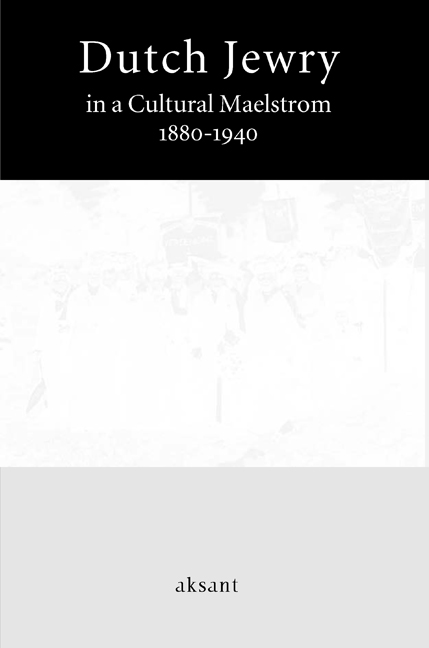Book contents
- Frontmatter
- Contents
- Foreword
- The New “Mosaik”: Jews and European Culture, 1750-1940
- The Politics of Jewish Historiography
- “The First Shall be the Last”: The Rise and Development of Modern Jewish Historiography in the Netherlands Until 1940
- Epigones and Identity: Jewish Scholarship in the Netherlands, 1850-1940
- Judaism on Display: The Origins of Amsterdam's Jewish Historical Museum
- De Vrijdagavond as a Mirror of Dutch Jewry in the Interbellum, 1924-1932
- “Holland is a Country which Provokes Serious Reflection…”: Images of Dutch Jewry in the German Jewish Press
- Spinozism and Dutch Jewry between 1880 and 1940
- Spinoza's Popularity in Perspective: A Dutch-German Comparison
- Mozes Salomon Polak: Jewish “Lerner” and Propagator of Freemasonry, Spiritualism, and Theosophy
- Jewish Women, Philanthropy, and Modernization: The Changing Roles of Jewish Women in Modern Europe, 1850-1939
- Roosje Vos, Sani Prijes, Alida de Jong, and the others: Jewish Women Workers and the Labor Movement as a Vehicle on the Road to Modernity
- Stemming the Current: Dutch Jewish Women and the First Feminist Movement
- Dutch Jewish Women: Integration and Modernity
- Index of Names of Persons
- Index of Subjects
De Vrijdagavond as a Mirror of Dutch Jewry in the Interbellum, 1924-1932
Published online by Cambridge University Press: 26 January 2021
- Frontmatter
- Contents
- Foreword
- The New “Mosaik”: Jews and European Culture, 1750-1940
- The Politics of Jewish Historiography
- “The First Shall be the Last”: The Rise and Development of Modern Jewish Historiography in the Netherlands Until 1940
- Epigones and Identity: Jewish Scholarship in the Netherlands, 1850-1940
- Judaism on Display: The Origins of Amsterdam's Jewish Historical Museum
- De Vrijdagavond as a Mirror of Dutch Jewry in the Interbellum, 1924-1932
- “Holland is a Country which Provokes Serious Reflection…”: Images of Dutch Jewry in the German Jewish Press
- Spinozism and Dutch Jewry between 1880 and 1940
- Spinoza's Popularity in Perspective: A Dutch-German Comparison
- Mozes Salomon Polak: Jewish “Lerner” and Propagator of Freemasonry, Spiritualism, and Theosophy
- Jewish Women, Philanthropy, and Modernization: The Changing Roles of Jewish Women in Modern Europe, 1850-1939
- Roosje Vos, Sani Prijes, Alida de Jong, and the others: Jewish Women Workers and the Labor Movement as a Vehicle on the Road to Modernity
- Stemming the Current: Dutch Jewish Women and the First Feminist Movement
- Dutch Jewish Women: Integration and Modernity
- Index of Names of Persons
- Index of Subjects
Summary
BEGINNINGS
The period between the final quarter of the nineteenth century and the onset of the economic depression in the 1930s was one of an enormous boom in the publication of journals and magazines in Europe, both academic and popular. The invention of inexpensive and fast techniques for reproducing photographs in the 1890s led to the emergence of a new genre: the illustrated weekly. The Netherlands formed no exception to this general trend, as is attested to by the list of magazines received by the Nieuwsblad voor den Boekhandel and published between January 1921 and January 1934. The issue of 1922 consisted of fifty-five pages. The list for 1931 (commencing on April 1, 1931, and ending on June 30, 1932) counted ninety pages and was the most expansive. The final issue covering a period of two years – between May 1, 1932, and January 31,1934 – showed a decrease in pages (eighty-six) and an increase in the list of publications no longer in press. A glance at the list of magazines available at the public reading room and library on the Keizersgracht in Amsterdam in 1924 sheds some light on the interests of the Dutch urban middle class. Aside from the various publications concerning trade and commerce, one notices an interest in the arts (Boek en Kunst, Beeldende Kunst), interior design (In en om de Woning), history (Onze Eeuw, Het Gemeenebest), education (Het Kind, Het Onderwijs, De Katholieke School), literature and drama, psychology, and women's rights. The presence of the monthlies of the Central Bureau of Statistics and the Amsterdam Bureau of Statistics as well as those of the homeopathic, theosophical, animal protection, and vegetarian societies in the reading room implies that the readership was not limited to specialists or society members. Finally, and not surprisingly in a pillarized society, the library subscribed not only to Catholic and Protestant publications but also to Jewish magazines, specifically Het Centraalblad voor Israëlieten in Nederland (1885-1940), Der Jude (1916-1928, subscription as of 1919), Mizrachie (1916-1940 and 1949-1951), De Joodse Wachter (1905 onwards), Het Nieuw Israelietisch Weekblad (1865), and Het Weekblad voor Israelitische Huisgezinnen (1870-1940). De Vrijdagavond was not yet listed as the trial issue first appeared on January 11, 1924. The weekly appeared until 1932, when the worldwide financial crisis led to its demise.
- Type
- Chapter
- Information
- Dutch Jewry in a Cultural Maelstrom1880-1940, pp. 85 - 96Publisher: Amsterdam University PressPrint publication year: 2008



